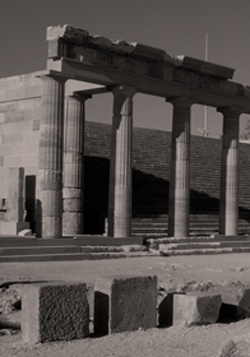Author: V. Santoro
download article as .pdf: Il Santuario ellenistico romano di Agrigento: ragioni, principi e metodi per una proposta di anastilosi
 Since 1988, systematic archaeological excavations directed by Ernesto De Miro were carried out in the area located north of Poggio di San Nicola, situated in the center of the ancient city of Agrigentum. During these researches, implemented until 2005-2006, a porched square dominated by a temple was brought to light. The team of the Department of Civil Engineering Sciences and Architecture (DICAR) of the Polytechnic of Bari, in accordance with the Parco Archeologico e Paesaggistico della Valle dei Templi, starting from 2012, initiated a critical revision of the previous investigations concerning the study of the monumental areas next to the upper agora of Agrigentum, also with the aim of enhancing them. The new researches, that contributed to clarify the architectural arrangement and the several phases of the porched complex North of the agora, provided useful data for the proposal of an anastylosis for a portion of the northern porch, to be coordinated by author of the present paper. This contribution aims to stress the interdisciplinary methodology that, from the archaeological excavation, led, on scientific and philological bases, to propose a project for an overall reconstruction to enhance a monument and an area whose original ancient centrality is going to be reestablished again in the current guided tours of the Parco.
Since 1988, systematic archaeological excavations directed by Ernesto De Miro were carried out in the area located north of Poggio di San Nicola, situated in the center of the ancient city of Agrigentum. During these researches, implemented until 2005-2006, a porched square dominated by a temple was brought to light. The team of the Department of Civil Engineering Sciences and Architecture (DICAR) of the Polytechnic of Bari, in accordance with the Parco Archeologico e Paesaggistico della Valle dei Templi, starting from 2012, initiated a critical revision of the previous investigations concerning the study of the monumental areas next to the upper agora of Agrigentum, also with the aim of enhancing them. The new researches, that contributed to clarify the architectural arrangement and the several phases of the porched complex North of the agora, provided useful data for the proposal of an anastylosis for a portion of the northern porch, to be coordinated by author of the present paper. This contribution aims to stress the interdisciplinary methodology that, from the archaeological excavation, led, on scientific and philological bases, to propose a project for an overall reconstruction to enhance a monument and an area whose original ancient centrality is going to be reestablished again in the current guided tours of the Parco.





